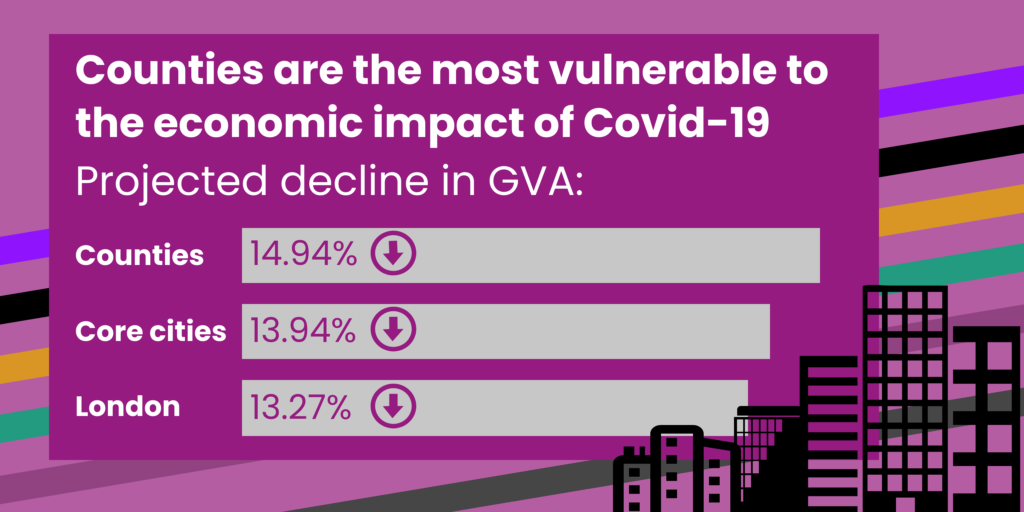
CCN Latest News, CCN News 2020 | 04 August 2020

The report from Grant Thornton UK LLP for the County Councils Network concludes that county areas are potentially more vulnerable to the economic impact of the virus compared to England’s major cities, arguing that the pandemic will exacerbate this divide without quick targeted investment and major new powers for counties to drive recovery plans in the longer-term.
Download the report here.
With 3.5m employees in the 36 counties featured in the study currently furloughed, county leaders fear that a significant number of those people will not have jobs to go back to once the scheme ends in October and have called on the government provide them with devolved powers to protect employment.
With the government set to unveil a fresh drive for devolution deals in a white paper in September, county leaders say that the government should grant them powers, particularly over transport and skills, that metro mayors currently have, otherwise their efforts in economic growth will be hamstrung.
The report, ‘Place-Based Recovery: How counties can drive growth post COVID-19’, reveals:
Grant Thornton recommends that targeted investment needs to focus on the county areas identified to help narrow the gap between high-growth areas and those with lower growth, otherwise the pandemic will exacerbate the divide between the major cities and England’s shire counties that the government’s ‘levelling-up’ agenda sought to address.

Looking longer term, an effective recovery will be hugely assisted by devolved powers and resource, particularly over skills and transport to re-train people into new jobs in a new economy, whilst providing both the physical and digital infrastructure for growth. These are powers currently enjoyed by metro mayors in areas whose economic growth prospects are better than counties, and the report concludes that new powers and budgets will create more effective local recoveries.
This will be integral to the government’s longer-term ‘levelling-up’ agenda which the Prime Minister re-affirmed his administration’s commitment to in a speech in July. To fulfil county leaders’ ambitions, the government must set out a clear pathway for devolved powers in its white paper in September, CCN argues.
 Cllr David Williams, chairman of the County Councils Network, and leader of Hertfordshire County Council said:
Cllr David Williams, chairman of the County Councils Network, and leader of Hertfordshire County Council said:
“The scale of the economic challenge posed by Coronavirus cannot be overstated and today’s research illustrates how exposed county areas are with over half of those areas’ workforces currently in sectors ‘’at risk’. We fear a significant number of those furloughed will not have employment to go back to unless we act now.
“There is a real risk the pandemic simply exacerbates the longstanding economic divide between county areas and the major cities, with urban metro mayors having more powers and resources at their disposal to address the impact of Coronavirus.
“County authorities must be a central part of the economic growth jigsaw, alongside the Government’s ‘Plan for Jobs’ and efforts from business and the education sector. Each area will have differing needs, and we know our residents and businesses well. Restructuring councils with devolved powers to new and ambitious unitary authorities will allow us to grasp the ‘levelling-up’ nettle and provide hope to our communities.”
 Paul Dossett, head of local government, Grant Thornton UK LLP, commented:
Paul Dossett, head of local government, Grant Thornton UK LLP, commented:
“COVID-19 has had profound and significant social, health and economic impacts across the country; impacts that have changed behaviours, disrupted markets and placed enormous pressure on public services. The scale of the economic disruption has demanded a fundamental rethink around economic development and growth.
“Our research shows the critical leadership role that county authorities can play in driving UK economic recovery, but also outlines the ongoing and unique challenges that these areas face. While COVID-19 has affected all parts of the country, the impact plays out very differently across different demographics and geographies. How particular vulnerabilities are managed and mitigated, and economic opportunities maximised, will look very different around the country.
“Effective recovery therefore demands an intimate knowledge of place. COVID-19 initially required a central response to managing the spread of the virus but, as we move from managing the crisis to managing the recovery, powers and decision making need to filter back to local places enabling them to take action on those issues or opportunities most pertinent to their area.”

Notes to editor
© 2024 County Councils Network | Credits | Site map | Cookies | Privacy Policy.